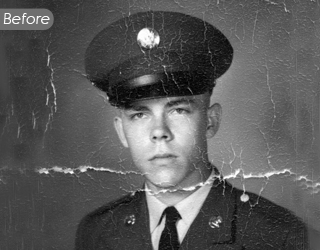

So now when I’m ready to retouch a portrait, I simply hit Shift+F8 and the action runs automatically so that when I start manually retouching by hand I’m working on an image that’s already better than the original. With the checkboxes adjacent, I can require a shift or command key to be held down along with the function key in order to trigger the action, which is a great workaround if you already have those function keys assigned to other actions. Here I can assign a shortcut key by choosing a function key (such as F4 or F5) to trigger the action. It’s for this reason that I sometimes set my neural filter to be a little bit heavy-handed because I know I can bring it back toward a more natural look simply by decreasing the opacity of the filtered layer.Īfter ceasing the recording, I go to the Photoshop Actions palette and double-click on the name of the action I’ve just made in order to bring up the Action Options window. It’s this ability of the Duplicate Layer option and the New Layer option that makes them my preference because not only can I easily see a before and after view, I can also dial back the impact of the filter by dragging down the opacity slider on the filtered layer, showing more of the unretouched original. “Duplicate Layer” creates a copy of the whole original layer with the neural edits applied so you can toggle it on and off to see a before and after view. “New layer” applies them to a new and otherwise blank image layer, preserving the untouched original layer below. The “current layer” option applies them directly to the background layer that you were working on. This is asking where you’d like Photoshop to place these newly retouched pixels. Down at the bottom of the Neural Filters window is a dropdown menu next to the word Output.
MALE BLACK AND WHITE PORTRAIT RETOUCHING SKIN
At this point, you’ll see in your image file that the skin has in fact become notably smoother.īefore clicking okay to render the smoothing, there’s one more thing to click.

Next, I adjust the second slider, for Smoothness, and dial it down around -10 to -15. So I start by simply dialing down the Blur Slider to 30 or 40. And while there are a lot of different ways it can be deployed, I find that a “less is more” approach usually works quite well. This filter itself is fairly simple and straightforward. Next, I open the Neural Filters on the Filter menu and click the slider next to Skin Smoothing to turn on (and download, if necessary) the skin smoothing filter. Next, click the record button in the actions palette and note that from here on out everything you do is being recorded by Photoshop for playback. To set up skin smoothing from Neural Filters in an action, start with an open portrait image file. Once Photoshop has automatically improved the skin, I’m then set up to make the final fine-tuning retouching adjustments by hand that are the hallmark of a really finely retouched portrait.
MALE BLACK AND WHITE PORTRAIT RETOUCHING MANUAL
Instead of using an action to record a series of manual tasks, I use the action to record a skin smoothing Neural Filter. I used to do all my retouching manually using a multi-step technique called frequency separation-which I also kicked off with a shortcut key-activated Photoshop action-but the Neural Filters achieve a similar effect in an even more efficient manner. With the advent of Neural Filters, Photoshop has made skin smoothing and face retouching easier and more automatic than ever. Here’s just one of the ways I deploy actions to make my editing process faster and better.

I do this-literally-with every image I edit. You can even assign a shortcut key-such as “Shift F8”-to any action so you can hit that key combo one time and the entirety of the action will proceed. And if you’d like Photoshop to prompt you to input specific values along with any step, click to check the “toggle dialog on and off” box found next to the step’s primary checkbox. And when you’re done recording, you can always toggle the steps in your action on and off by clicking the checkbox next to each step in the Actions palette. If you make a mistake during the recording process you can stop, undo, go back and restart recording at any point. You may now give your recording a name and file it away with other complementary actions. After deliberately carrying out your series of edits, click the square icon to stop recording. So when you’re ready to record a process, click record.

At the bottom of the window, you’ll see a round icon that, after clicking, records every mouse click you make. To set up and record a Photoshop action, first open the Actions palette.


 0 kommentar(er)
0 kommentar(er)
